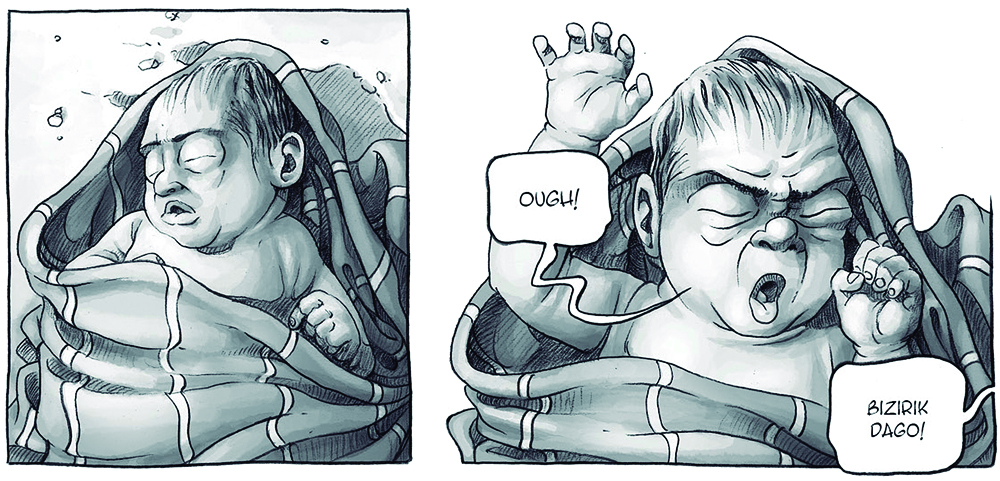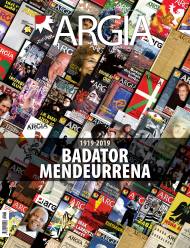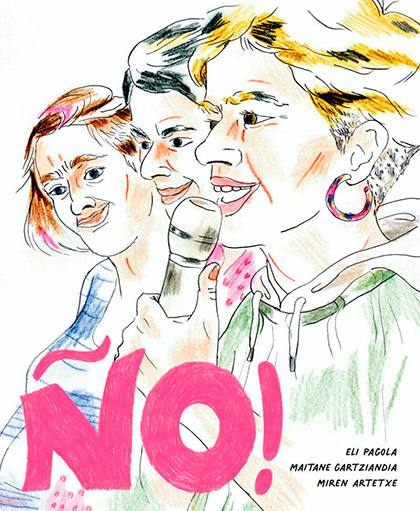Comics seeks a place in the culture in which the word predominates.
- On the days when the Durango Fair brings together the world of Basque culture, books, letters, letters and letters will be topics of conversation. What about the images? There is a small flourishing in the Basque comic book or, more broadly, in the field of graphic literature. In the following lines we highlight some interesting news of this year, using only letters, yes.

“Comic lovers rarely have the opportunity to read the authors we like in our language, and that’s why every time an interesting author is published, and once again, every time we have to read in French, Spanish, or English, or in any other language, we always come to the head one and the same question: What crosses of astros do you have to do here to meet each other and be able to do that kind of shields in our language? La cuestación has two possible answers: one was Ubeda herself, who gave the press in the Komikigunea de Donostia, two crossed astros on both sides of the table, David Zapirain and Koldo Izagirre, thanks to which it has been possible to transfer and publish this Italian comic book to the Basque Country in the editorial Farmacia Beltza, ahead of the French translation.
But the question – remember: the crossing of astros that must be done to read the comic in our language – could have, at least, another possible answer, which asked the journalist to take a picture of the time of the Basque comic book, and which occurred to him while drawing in a small notebook what was said in that press conference. He raised his head as if it helped him think, and he saw Dani Fano in the bank next door. I had read Teleatoi and Anubis 3.0 and knew that he had just published the eleven and one of the births of Miguel Marble by the hand of the editorial Astiberri.
He started to recast: “Hey Dani, what would you look like if I asked you some questions for the magazine that we will post around the Durango Fair?” And here we are, a couple of weeks later, talking on the phone about a quarter of an hour of suffocated march, talking about the book you just published about the revolutionary Salvadoran.
Dani Fano:
“I recently heard Iratxe Retolaza say that Basque culture has been closely linked to the word and language, both oral and written; not
so much to the image”
Euskera and Spanish simultaneously
He explains that it has also been published on the other side of the ocean thanks to the Salvadoran Museum of Word and Image. It is a new experience for Fano, who has so far published almost everything in Basque. “I’m finding a very different world.” An example: in the presentation of the book come the Salvadorans living in the Basque Country, as if I wanted to know how we tell the historical character hidden there. “In addition, Astibe R makes a huge effort to sell its products in other languages. You have a great chance of moving in French, Italian or English, because they are very versatile.”
Publishing in two languages and with the help of an editorial that does not normally work in Basque: this experience has similarities with that which Maite Mutuberria has lived this year. He published Lohia in the spring with the Riojana publisher Pepitas de Calabaza, a graphic novel or, finally, an illustrated novel; but no, it's not that, come on, we'll send him a message asking, because our explanation will be pretty clumsy: “I like it’s not easy to classify, I don’t think readers need a classification. Perhaps the classification is exclusive to authors, bookstores and journalists. Lohia is the notebook of a crisis, born in intimate notebooks and has maintained that form: drawings, sketches, quotes, small notes, lights and shadows…”. One of the novelties this year has been the appearance of a personal crisis, a rare avis among the publications in Basque. And as it has also been published in Spanish, we wanted to know how the reception of each one of them has been: “I’ve noticed that here it has been picked up with more astonishment, probably because my previous work is more known. Many have told me that they didn’t expect a drawing of this kind from me, but I really feel this book.”
Therefore, two positive experiences in editorials outside the Basque circuit: Can this be one of the ways for the illustrators here to publish more? Mikel Begoña is not so convinced: he is a long-standing comic maker, has the latest reference from Arditakoa, published last year by Bertsolari magazine, and in the last six years he is closely following production in Basque in the blog Komikeri. He cited the Rock Paco Wrinkles or the Peeters blue pills, both published by Astiberri, but later than in the Spanish editions. “They have lost much of their interest. The papers are generally known,” he explains in response to the interrogation we have sent to him by e-mail. “Even when they are published at the same time, I believe that Euskera loses, because the products in Spanish are much more promoted. Often it seems that the editions in Basque are nothing more than substitutes for the editions in Spanish”.
Bets are accepted
Maite Mutuberria:
“The drawings have given me the opportunity to express, more sincerely, what I could not do through words. Many times we think too much when speaking or writing, while drawing we are more intuitive”
From the point of view, there is one thing clear: in graphic literature the offer of most Basque publishers is not very broad, although essays have been performed. When Alberdania published almost ten years ago Ihes ederra (Hedoi Etxarte, Alain Urrutia, 2009) seemed to be the beginning of a line of work, but it did not continue due to the vicissitudes that the publisher had.
For Fano, the editorial Txalaparta can be an exception in an editorial roulette that does not play many tokens in favor of the comic in general. “I recently heard Iratxe Retolaza say that Basque culture has been closely linked to the word and language, both oral and written; not so much to the image. I don’t know if that will be the explanation.” Nor are the economic reasons disposable, according to Begoña: “The launch of comics costs more than the launch of normal books, and the failure of a sale means a huge loss of money for publishers.” Therefore, the challenge is to increase the number of readers.
Eppur if muove
IS, but what do we do? Through this report we wanted to say that we have begun to notice something new in recent years, that there is a dynamism in this field that did not previously exist, and we have begun to revolve around our deficiencies without realizing it. Let's see, some numbers: From 2012 to the present, comic book production has increased to triple the number of titles published in 2017, according to Begoña’s follow-up. “This year’s harvest also comes very good, both in quantity and in quality.” They are things that rejoice, even with some “but” – we always have some, ai – that a significant part of that production has been promoted by the editorial Harriet de Gregorio Muro, which this year will publish nine albums and eight of the 30 books last year have been due to the work of this editorial. “So far it has been above all the obstacles – and the way comics are marketed is full of obstacles – but we don’t know how long Harriet Ediciones will keep going.”
However, there are other characteristics to think that the fact that graphic literature has acquired some strength in recent times has rather solid bases that are not the result of chance. The journal Xabiroi, published at the initiative of the Federation of Ikastolas, has brought new readers to the Basque comic book; it is difficult to measure its number, but equally clear that it has produced a side effect: a network of authors has been organized that are known regularly, and has also brought to the genre authors that had no relation to comics. “Attracting Harkaitz Cano, Eider Rodriguez, Arantxa Iturbe, Pako Aristi, Iban Zaldua to the comic book… has given us another focus,” according to Fano.
Mikel Begoña:
“Keeping the trend of previous years, this year’s harvest also comes very good, both in quantity and in quality”
What images can tell of reality
With different intentions and trends, the characteristic that unites several recent publications is that reality feeds the stories that are told through drawings. Begoña says that this year extraordinary works have been published in the context of the novel “BIOgrafica” – Adur Larrea is due to the expression – such as AztiHitza (Erroa), by Asisko Urmeneta, who tells the life of Agosti Xaho, and Mikel Santos “Belaitz”, about the entrepreneurs of the anarchist.
The Mutuberria Mud is also autobiographical. Why? “The drawings have given me the opportunity to express, more sincerely, what I could not do through words. Because many times we think too much about speaking or writing, while drawing makes us more intuitive,” he replies. Many authors seem to coincide with this opinion, as more and more self-fictionalized comics in bookstores, as well as the journalistic chronicles through cartoons: personal experiences, journalism or history; narratives that have the author or the community around him as raw material, more than pure fiction.
In Lohia’s case, the intention of telling something real that was at the starting point of the project was to “create a story that anyone could understand and feel from my day to day.” This is the philosophy defended by Fano: “It’s very natural to tell stories around you when it comes to telling something.” For the Donostian creator, it is now being made of everything in the world of comics and graphic literature can be a way of “telling the lives that we think are exemplary or novel”.
At least the journalist has been convinced that if he were a little longer, he would also publish this report in comic form. Some astros will still have to cross to make this happen.
Ihes plana
Agustín Ferrer Casas
Itzulpena: Miel A. Elustondo
Harriet, 2024
---------------------------------------------------------
1936ko azaroaren 16an Kondor legioko hegazkinek Madrilgo zenbait museori egin zieten eraso. Eta horixe bera da liburu honetara... [+]
SCk Zerocalcareri egindako galdera sorta eta honen erantzunak, jarraian.
Bildumako azken alea izango dela jakinarazi dute: lehenbizikoa Ni-ari buruzkoa izan zen, eta bigarrena Zu. Bigarren hura bezala, autoedizioan kaleratu du honakoa ere.
Ño!
Texts: Illustrations Eli Pagola and Miren
Artetxe: Luz Maitane
Gartziandia, 2023
------------------------------------------------------
Before and after the comic, both on the skin and back provided, as well as inside tapas and tapas, there are images and words... [+]
Biga (5 books)
Screenplay: Illustrations Romain
Pujol: Vincent Seguros
Astiberri
----------------------------------------------------
We've read eleven stories at home to our seven- and nine-year-olds, and I would say that I've never seen them so hooked that with the... [+]
Screenplay
Anker: Gregorio muro harriet
Illustrations: Alex Male
Color: Garluk Aguirre
Harriet, 2023
The Anker comic is located in January 2019. In the Russian regions, near the borders of China and North Korea. It shows the mafias that are flourishing the Siberian... [+]

























